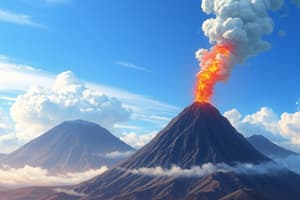Podcast
Questions and Answers
What type of lava is associated with effusive or non-explosive eruptions?
What type of lava is associated with effusive or non-explosive eruptions?
- Granitic lava
- Runny, low viscosity lava (correct)
- Thick, viscous lava
- Pyroclastic material
What is the typical height of a cinder cone volcano?
What is the typical height of a cinder cone volcano?
- Both a and b (correct)
- Up to 1312 feet
- Up to 3000 meters
- Up to 400 meters
Which type of volcano is considered the most explosive and dangerous?
Which type of volcano is considered the most explosive and dangerous?
- Shield volcanoes
- Composite volcanoes (correct)
- Effusive volcanoes
- Cinder cone volcanoes
What is the main difference between effusive and explosive eruptions?
What is the main difference between effusive and explosive eruptions?
What is the main feature that distinguishes cinder cone volcanoes from composite volcanoes?
What is the main feature that distinguishes cinder cone volcanoes from composite volcanoes?
What is the typical composition of the lava found in composite volcanoes?
What is the typical composition of the lava found in composite volcanoes?
Which type of volcano is expected to erupt again in the near future?
Which type of volcano is expected to erupt again in the near future?
What is a volcanic neck?
What is a volcanic neck?
Which of the following is an example of a dormant volcano?
Which of the following is an example of a dormant volcano?
What is the primary characteristic of a shield volcano?
What is the primary characteristic of a shield volcano?
Which type of volcano is at the end of its life and can no longer erupt?
Which type of volcano is at the end of its life and can no longer erupt?
What is the typical diameter of the base of a shield volcano?
What is the typical diameter of the base of a shield volcano?
Flashcards are hidden until you start studying




